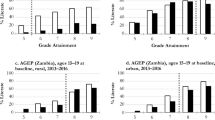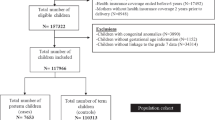Abstract
Objectives
To evaluate third-grade reading and math proficiency for children born to adolescent women compared with those born to non-adolescent women.
Methods
A statewide, retrospective cohort study was conducted in Rhode Island using third-grade year-end examination data from 2014 to 2017 as part of a statewide initiative to improve third grade reading levels. Children’s third-grade reading and math proficiencies were compared between those born to nulliparous adolescent women (age 15–19 at the time of delivery), and nulliparous women 20 years or older at delivery. Bivariate analyses were conducted to compare maternal and child characteristics between adolescent and non-adolescent groups. Multivariable logistic regression was used to examine the association between having an adolescent mother and being proficient in reading and math after adjusting for lunch subsidy, core city residence, child race/ethnicity and sex.
Results
Of the 8,248 children meeting the inclusion criteria, 20% were born to adolescent women and the remaining 80% were born to non-adolescent women. After adjusting for potential confounders, children born to adolescent women were significantly less likely to be proficient in both reading (adjusted risk ratio (aRR) 0.77, 95% confidence interval (CI): 0.71–0.83) and math (aRR 0.78, 95% CI: 0.72–0.85).
Conclusions for Practice
Children born to adolescent women had significantly lower rates of reading and math proficiency when compared with children of non-adolescent women. These children may benefit from additional resources focused on early academic performance in order to address disparities in reading and math proficiency.

Similar content being viewed by others
Data Availability
The research presented here utilizes confidential data from the Rhode Island Department of Education (RIDE). The views expressed here are those of the authors and do not necessarily represent those of RIDE or other data contributors. Any errors are attributable to the authors. Restrictions apply to the availability of these data, which were used under an agreement for the current study and so are not publicly available.
Code Availability
Custom code.
References
Barnet, B., Liu, J., DeVoe, M., Alperovitz-Bichell, K., & Duggan, A. K. (2007). May-Jun). Home visiting for adolescent mothers: effects on parenting, maternal life course, and primary care linkage. Annals of family medicine, 5(3), 224–232. https://doi.org/10.1370/afm.629.
Beers, L. A. S., & Hollo, R. E. (2009). 2009/10/01/). Approaching the Adolescent-Headed Family: a review of Teen Parenting. Current Problems in Pediatric and Adolescent Health Care, 39(9), 216–233. https://doi.org/10.1016/j.cppeds.2009.09.001.
Brooks-Gunn, J., & Furstenberg, F. F. (1986). The children of adolescent mothers: physical, academic, and psychological outcomes. Developmental Review, 6, 224–251.
Carneiro, P., Meghir, C., & Parey, M. (2013). Maternal education, Home environments and the development of children. Journal of the European Economic Association, 11, 123–160.
Centers for Disease Control and Prevention (2019). March 1 2019). About Teen Pregnancy. Retrieved March 22 from https://www.cdc.gov/teenpregnancy/about/index.htm
Chen, X. K., Wen, S. W., Fleming, N., Demissie, K., Rhoads, G. G., & Walker, M. (2007). Teenage pregnancy and adverse birth outcomes: a large population based retrospective cohort study. International Journal of Epidemiology, 36(2), 368–373. https://doi.org/10.1093/ije/dyl284.
Davis, L. L., & Moyer, E. L. (2015). Ph.D. PARCC Performance Level Setting Technical Report.
de Brey, C., Musu, L., McFarland, J., Wilkinson-Flicker, S., Diliberti, M., Zhang, A., Branstetter, C., & Wang, X. (2019). Status and Trends in the Education of Racial and Ethnic Groups 2018.
Fan, X., & Chen, M. (2001). 2001/03/01). Parental involvement and students’ academic achievement: a Meta-analysis. Educational Psychology Review, 13(1), 1–22. https://doi.org/10.1023/A:1009048817385.
Fleishman, E. B. (2004). Adolescent literacy: a national reading crisis. Scholastic Inc.
Harden, B. J., & Whittaker, J. V. (2011). 2011/08/01/). The early home environment and developmental outcomes for young children in the child welfare system. Children and Youth Services Review, 33(8), 1392–1403. https://doi.org/10.1016/j.childyouth.2011.04.009.
Hoffman, S. D. (2006). By the Numbers: The Public Costs of Teen Childbearing.
Hoffman, S. D., & Maynard, R. A. (2008). Kids having kids: economic costs & Social Consequences of Teen pregnancy (2nd ed.). The Urban Institute Press.
Jaffee, S., Caspi, A., Moffitt, T. E., Belsky, J., & Silva, P. (2001). Why are children born to teen mothers at risk for adverse outcomes in young adulthood? Results from a 20-year longitudinal study. Development and Psychopathy, 13, 377–397.
Johnson, W., McGue, M., & Iacono, W. G. (2007). Socioeconomic status and School Grades: placing their association in broader context in a sample of Biological and adoptive families. Intelligence, 35(6), 526–541. https://doi.org/10.1016/j.intell.2006.09.006.
Kane, J. B., Morgan, P., Harris, S., K. M., & Guilkey, D. K. (2013). Dec). The educational consequences of teen childbearing. Demography, 50(6), 2129–2150. https://doi.org/10.1007/s13524-013-0238-9.
Kern, M. L., & Friedman, H. S. (2008). Early educational milestones as predictors of lifelong academic achievement, midlife adjustment, and longevity. Journal of applied developmental psychology, 30(4), 419–430. https://doi.org/10.1016/j.appdev.2008.12.025.
Kinard, E. M., & Reinherz, H. (1987). School aptitude and achievement in children of adolescent mothers. Journal of Youth and Adolescence, 16(1), 69–87.
Moffitt, T. E. (2002). Teen-aged mothers in contemporary Britain. Journal of Child Psychology and Psychiatry, 43(6), 727–742. https://doi.org/10.1111/1469-7610.00082.
New York City Independent Budget Office (2017). From Grades 3 to 8: Tracing Changes in Achievement Gaps by Race & Gender in New York City Public Schools.
Partnership for Assessment of Readiness for College and Careers (2017). PARCC Spring 2017 Score Report Interpretation Guide.
Rhode Island Department of Health (2012). Rhode Island Department of Health Guidelines for Adoption of New Core City Designation, December 2012 Retrieved February 12, 2021 from https://health.ri.gov/publications/guidelines/CoreCityData.pdf
Rhode Island, K. I. D. S. C. O. U. N. T. (2018). 2018 Rhode Island Kids Count Factbook Providence, RI.
Roye, C. F., & Balk, S. J. (1996). 1996/08/01/). The relationship of partner support to outcomes for teenage mothers and their children: a review. Journal of Adolescent Health, 19(2), 86–93. https://doi.org/10.1016/1054-139X(95)00278-Z.
Schuyler Center for Analysis and Advocacy (2008). Teenage Births: Outcomes for Young Parents and their Children.
The Annie E. Casey Foundation (2010). Early Warning! Why Reading by the End of Third Grade Matters. Baltimore, MD.
The Annie E. Casey Foundation (2012). Double jeopardy: How third grade reading skills and poverty influence high school graduation Baltimore, MD:Donald J. Hernandez.
Thomson, S. (2018). 2018/03/23). Achievement at school and socioeconomic background—an educational perspective. npj Science of Learning, 3(1), 5. https://doi.org/10.1038/s41539-018-0022-0.
Wagner, K. (2016). Rhode Island’s PARCC Results for Students in Grades 3 through 8 and High School 2015 to 2016: A Look at Our Progress.
Williams, B. L., Dunlop, A. L., Kramer, M., Dever, B. V., Hogue, C., & Jain, L. (2013). Perinatal Origins of First-Grade Academic failure: role of Prematurity and maternal factors. Pediatrics, 131(4), 693. https://doi.org/10.1542/peds.2012-1408.
World Health Organization (2020). Adolescent Pregnancy. Retrieved March 21 from https://www.who.int/news-room/fact-sheets/detail/adolescent-pregnancy
Author Acknowledgements
We would like to thank the Hassenfeld Child Health Innovation Institute for their support for this project.
The research presented here utilizes confidential data from the Rhode Island Department of Education (RIDE). The views expressed here are those of the authors and do not necessarily represent those of RIDE or other data contributors. Any errors are attributable to the authors.
Funding
This project is supported by the Hassenfeld Child Health Innovation Institute.
Author information
Authors and Affiliations
Contributions
The authors confirm contribution to the paper as follows: study conception and design: EFW, CAG, LES, NKA; data collection: LES; analysis and interpretation of results: CAG, LES, NKA; draft manuscript preparation: CAG, LES, EFW, PMV, RRC, NKA. All authors reviewed the results and approved the final version of the manuscript.
Corresponding author
Ethics declarations
Conflict of Interest
The authors declare that they have no conflict of interest.
Ethics Approval
This study was approved by the Rhode Island Department of Health Institutional Review Board.
Consent to Participate
Not applicable.
Consent for publication
Not applicable.
Additional information
Publisher’s Note
Springer Nature remains neutral with regard to jurisdictional claims in published maps and institutional affiliations.
Rights and permissions
Springer Nature or its licensor (e.g. a society or other partner) holds exclusive rights to this article under a publishing agreement with the author(s) or other rightsholder(s); author self-archiving of the accepted manuscript version of this article is solely governed by the terms of such publishing agreement and applicable law.
About this article
Cite this article
Grossman, C.A., Schlichting, L.E., Werner, E.F. et al. Third-Grade Educational Outcomes of the Children of Adolescent Women. Matern Child Health J 27, 508–515 (2023). https://doi.org/10.1007/s10995-022-03565-5
Received:
Revised:
Accepted:
Published:
Issue Date:
DOI: https://doi.org/10.1007/s10995-022-03565-5




